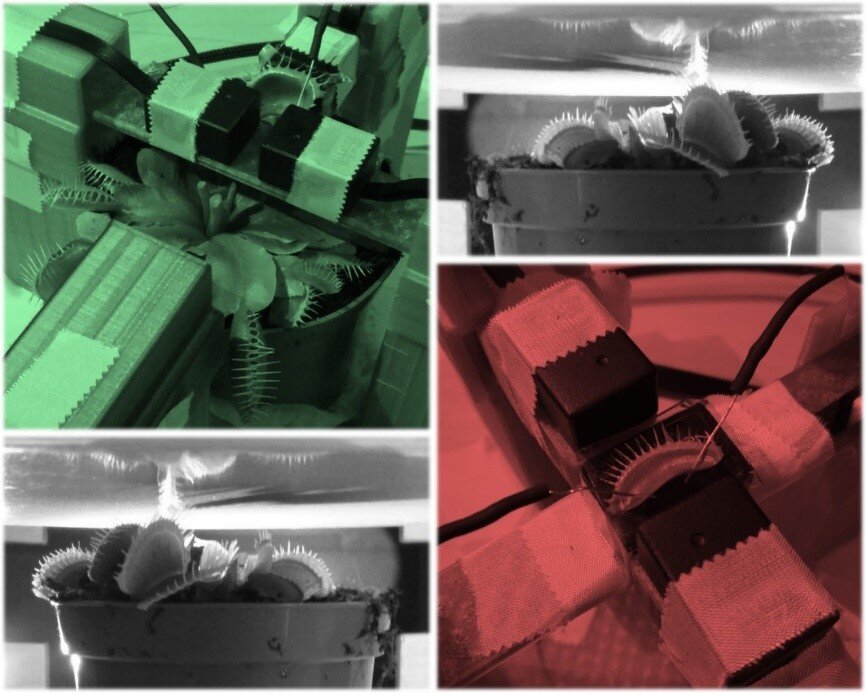Venus flytraps produce magnetic fields when they eat
These carnivorous plants generate tiny magnetic signals when they clamp down on insects.

Carnivorous plants known as Venus flytraps (Dionaea muscipula) lure insects between their blushing leaves with a fragrant nectar. When these insect-hungry plants snap down on their unassuming prey, they generate a measurable magnetic field, according to a new study.
The plant's magnetic field is more than a million times weaker than Earth's. Rather than serving a function for the plant this magnetic field is likely a byproduct of electrical energy that flows through its leaves, said lead author Anne Fabricant, a doctoral candidate at Johannes Gutenberg University Mainz and the Helmholtz Institute Mainz in Germany. Still, it's one of the first such fields ever detected in plants.
"Wherever there is electrical activity, there should also be magnetic activity," Fabricant told Live Science. The laws of electromagnetism dictate that anything with an electrical current also generates a magnetic field; and that includes humans, animals and plants. In fact, it's such a common phenomenon among living things that there's a name associated with it: biomagnetism. But while much research focused on such magnetic fields in humans and animals, not much has been done to understand biomagnetism in the plant world.
Book of Incredible Science: $22.99 at Magazines Direct
Journey from our early beginnings as a species, exploring how we came to be and how our immune systems, emotions and even fears developed. Meet some of science’s greatest minds and discover how vaccines were created, the illumination of the light spectrum and how we explain phenomena from "vampires" to out-of-body experiences. Explore the power behind nuclear fusion and the endless possibilities offered by quantum mechanics and more in the "Book of Incredible Science".
Related: Image gallery: carnivorous plants
In the new study, Fabricant and her team used tiny glass sensors called "atomic magnetometers" that contain a vapor of atoms that are sensitive to magnetic fields, according to a statement. They then triggered electrical energy, in the form of an action potential, to flow through the Venus flytrap. Action potentials, which also occur in animal and human nervous systems, are bursts of electrical energy that allow cells to communicate.
Action potentials serve a "vital" function for the Venus flytrap, triggering the plant to close its leaves around insects that touch sensitive hairs on the plants' leaves, Fabricant said.
But the researchers stimulated the plant in another way, by using heat. They found that when stimulated, the Venus flytrap created a magnetic field up to a strength of 0.5 picotesla. That's similar to the levels generated by nerve impulses in animals, according to the statement.
Get the world’s most fascinating discoveries delivered straight to your inbox.
Magnetic fields have only been detected in two other plants prior to this study, a single-cell algae and a bean plant, Fabricant said. But those were measured using superconducting-quantum-interference-device (SQUID) magnetometers, which are just as bulky as their name and need to be cooled to extremely low temperatures, she said.

"It's exciting to demonstrate plant-biomagnetic measurements using atomic magnetometers, which operate at room temperature and can be portable and miniaturized," Fabricant said. "The fact that we were able to detect magnetic fields gives some hints about how electric currents are distributed in the trap." The researchers hope to measure even tinier magnetic fields in other plant species, according to the statement.
The findings were published Jan. 14 in the journal Scientific Reports.
Originally published on Live Science.

Yasemin is a staff writer at Live Science, covering health, neuroscience and biology. Her work has appeared in Scientific American, Science and the San Jose Mercury News. She has a bachelor's degree in biomedical engineering from the University of Connecticut and a graduate certificate in science communication from the University of California, Santa Cruz.
 Live Science Plus
Live Science Plus






